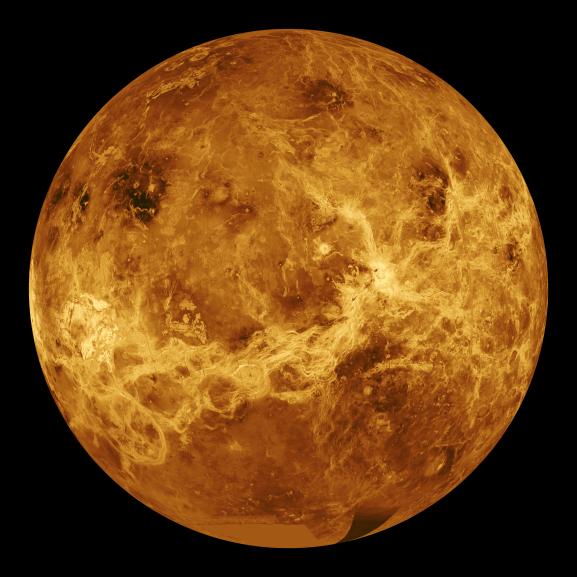Venus, the second planet from the Sun, is often referred to as Earth’s sister planet. If an alien on a distant exoplanet were to observe our solar system using the same technology that Earth-based astronomers use today, the two would appear nearly identical. They’re both rocky planets, with roughly the same diameter and mass. They’re both located in the inner solar system and within or relatively close to the habitable zone. But only one undisputably hosts life.
The second major difference between the two planets, and the likely reason behind the first, lies in their atmospheres. Earth’s atmosphere is about 78% nitrogen and 21% oxygen, while Venus’s atmosphere is more than 96% carbon dioxide. At some point in the distant past, volcanoes released this carbon dioxide, triggering a runaway greenhouse effect. This process, along with its proximity to the Sun, left the surface of Venus a scorching 500°C or 900°F.
Harold Morowitz and Carl Sagan first noted in 1967 that Venus’s sterilizing surface may be hostile to life as we know it, but its clouds are “a different story altogether.” Venus’s upper atmosphere contains low levels of water vapor, and cloud regions where the temperatures and pressures are amenable to some Earth-based microbes. Scientists studying Venus’s clouds in the 1970s found that they consist almost entirely of sulfuric acid, which is generally thought to be incompatible with life. But controversial detections of phosphine – a gas produced by microbes on Earth – in Venus’s clouds have prompted some astrobiologists to reconsider their potential habitability.
In the past, these researchers demonstrated that biomolecules like nucleic acids, which form DNA, are stable for up to a year in 81% to 98% sulfuric acid. To further this investigation, scientists from the University of Chicago recently tested whether more complex organic structures could also form in concentrated sulfuric acid.
They started with a set of carbon-based molecules called lipids. Lipids form the scaffolding for cell membranes. Cell membranes, in turn, act as a barrier to the external environment and control what goes into and out of the cells. The team argued that cell membranes are a prerequisite for life, particularly under extreme conditions like the Venusian clouds. So they tested whether simple lipids could form membrane-like structures, called vesicles, in concentrated sulfuric acid.
Membrane lipids have one side that’s attracted to water, referred to as hydrophilic, and one side that repels water, referred to as hydrophobic (shown below, left). The hydrophilic side is composed of a long chain of carbon atoms, called a tail. The hydrophobic side contains a charged compound, called a polar head. In a cell membrane, lipids are arranged into two layers with their hydrophilic tails facing inward and their hydrophobic heads facing outward (shown below, right). The team chose simple, commercially available lipids with tails of 10 or 18 carbon atoms, and polar heads of trimethylamine, sulfate, and phosphonate. They explained that lipids with these tails are short enough to be soluble but still hydrophobic enough to form membrane structures.

Diagram of a single simple lipid (left) and stacked lipids creating a cell membrane structure (right). Created by the author.
To determine if the lipids could resist attack by sulfuric acid, they incubated various concentrations of each 10-carbon lipid in 1%, 30%, and 70% sulfuric acid for at least one hour at room temperature. They used a method that identifies the structure of molecules based on their magnetic properties to see whether the lipids changed in increasing acid concentrations. They found that the trimethylamine and phosphonate lipids remained intact in up to 70% sulfuric acid, but about 20% of the sulfate heads broke down.
Next, the researchers tested whether the lipids were forming vesicles in these sulfuric acid solutions. They prepared low to high concentrations of lipid mixtures in 70% to 90% sulfuric acid. Then, they measured particle sizes in the lipid-acid mixtures based on how they scattered light. They found that 50/50 mixtures of either 10-carbon lipids or 18-carbon lipids formed particles about the same size as typical vesicles in 70% and 80% sulfuric acid solutions. And these particles remained stable even after 7 days.
The team examined the lipid particles with a high-powered microscope and confirmed that they formed bubble-like vesicles. Finally, they used numerical models to demonstrate that the charged ends of the lipid and acid molecules could interact with each other at the molecular level to stabilize a vesicle and prevent acid from entering it.
The researchers concluded that simple lipids can form stable, membrane-like structures in sulfuric acid concentrations similar to the clouds of Venus. As a next step, they suggested that future researchers conduct laboratory experiments to test their molecular models and determine whether lipid membranes can indeed keep sulfuric acid out. These scientists are starting to develop a picture of the type of life that could exist in the Venusian cloud layer, but the image remains largely a blur.


